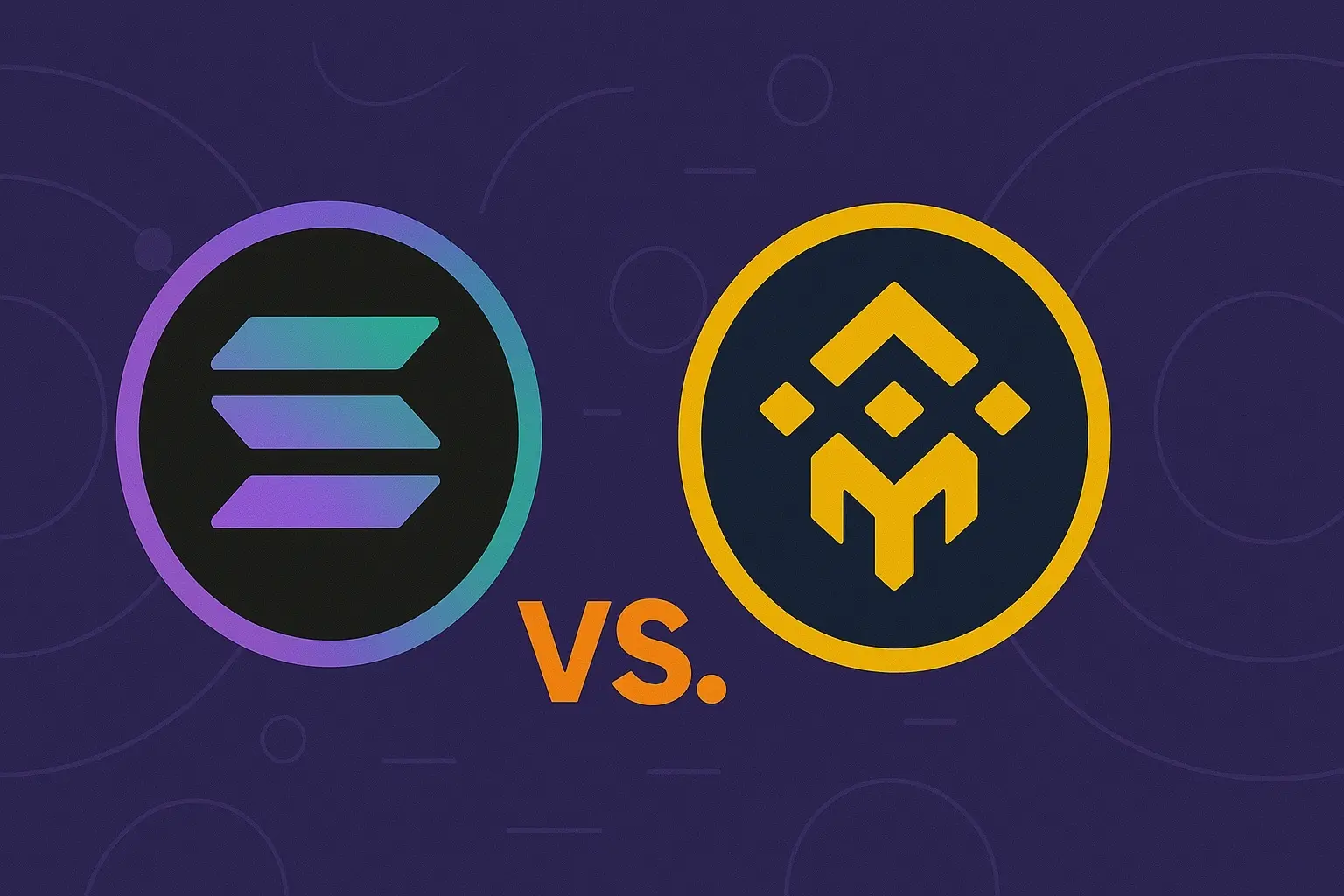Differences in Staking Business Models between Ethereum and Solana: Starting from Lido and Solayer
Author: Lawrence Lee, Mint Ventures
After securing two rounds of financing, including a $12 million round led by Polychain and funding from Binance Labs, the restaking project Solayer on the Solana chain has become one of the few highlights in the DeFi space recently, with its TVL continuing to rise. It has now surpassed Orca, ranking twelfth in TVL on the Solana chain.
 Solana Project TVL Rankings Source: DeFillama
Solana Project TVL Rankings Source: DeFillama
The staking track, as a crypto-native sub-sector and the largest crypto sector by TVL, has seen its representative tokens LDO, EIGEN, ETHFI, and others struggle in this cycle. Aside from the Ethereum network they are part of, could there be other reasons?
- How competitive are the staking and restaking protocols surrounding user staking behavior within the entire staking ecosystem?
- What are the differences between Solayer's restaking and Eigenlayer's restaking?
- Is Solayer's restaking a good business?
This article aims to answer the above questions. We will start with the staking and restaking on the Ethereum network.
Competitive Landscape and Development Pattern of Liquid Staking, Restaking, and Liquid Restaking on the Ethereum Network
In this section, we will mainly discuss and analyze the following projects:
The leading liquid staking project Lido, the leading restaking project Eigenlayer, and the leading liquid restaking project Etherfi.
Lido's Business Logic and Revenue Composition
The business logic of Lido can be summarized as follows:
Due to Ethereum's commitment to decentralization, the PoS mechanism of ETH has soft limits on the staking cap per node. A single node can only deploy a maximum of 32 ETH to achieve higher capital efficiency, while staking requires relatively high hardware, network, and knowledge requirements, making it difficult for ordinary users to participate in ETH staking. In this context, Lido has popularized the concept of LST. Although the liquidity advantage of LST has been weakened after the Shapella upgrade opened withdrawals, its advantages in capital efficiency and composability remain solid, forming the basic business logic of LST protocols represented by Lido. In the liquid staking sector, Lido's market share is close to 90%, leading the market.
 Liquid Staking Participants and Market Share Source: Dune
Liquid Staking Participants and Market Share Source: Dune
The revenue of the Lido protocol mainly comes from two parts: consensus layer revenue and execution layer revenue. The so-called consensus layer revenue refers to the PoS issuance rewards of the Ethereum network. For the Ethereum network, this expenditure is for maintaining network consensus, hence it is called consensus layer revenue, which is relatively fixed (the orange part in the chart below); while execution layer revenue includes priority fees paid by users and MEV (for an analysis of execution layer revenue, readers can refer to Mint Ventures' previous article for more information). This part of the revenue is not paid by the Ethereum network but is paid (or indirectly paid) by users during transaction execution, and it varies with on-chain activity, showing significant volatility.
 Lido Protocol APR Source: Dune
Lido Protocol APR Source: Dune
Eigenlayer's Business Logic and Revenue Composition
The concept of restaking was proposed by Eigenlayer last year and has become a rare new narrative in the DeFi space and the entire market over the past year, giving rise to a series of projects with an FDV exceeding $1 billion at launch (besides EIGEN, there are ETHFI, REZ, and PENDLE), as well as many yet-to-launch restaking projects (Babylon, Symbiotic, and the Solayer we will focus on later). The market's enthusiasm is evident (Mint Ventures previously conducted research on Eigenlayer last year, interested readers can check it out).
Eigenlayer's Restaking, as defined, allows users who have already staked ETH to restake their staked ETH on Eigenlayer (thus obtaining additional rewards), hence the name 'Re'Staking. Eigenlayer refers to the services it provides as AVS (Actively Validated Services), which can serve various protocols that require security, including sidechains, DA layers, virtual machines, oracles, bridges, threshold encryption schemes, and trusted execution environments. EigenDA is a typical example of a protocol using Eigenlayer's AVS services.

 Protocols currently using Eigenlayer AVS Source: Eigenlayer Official Website
Protocols currently using Eigenlayer AVS Source: Eigenlayer Official Website
Eigenlayer's business logic is also quite simple. On the supply side, they raise assets from ETH stakers and pay fees; on the demand side, protocols that require AVS pay to use their services, with Eigenlayer acting as a "protocol security market" to facilitate and earn certain fees.
However, looking at all current restaking projects, the only real revenue remains the tokens (or points) of the related protocols. We cannot yet determine if restaking has achieved PMF: on the supply side, everyone likes the extra rewards brought by restaking; but the demand side remains a mystery: are there really protocols willing to purchase protocol economic security services? If so, how many?
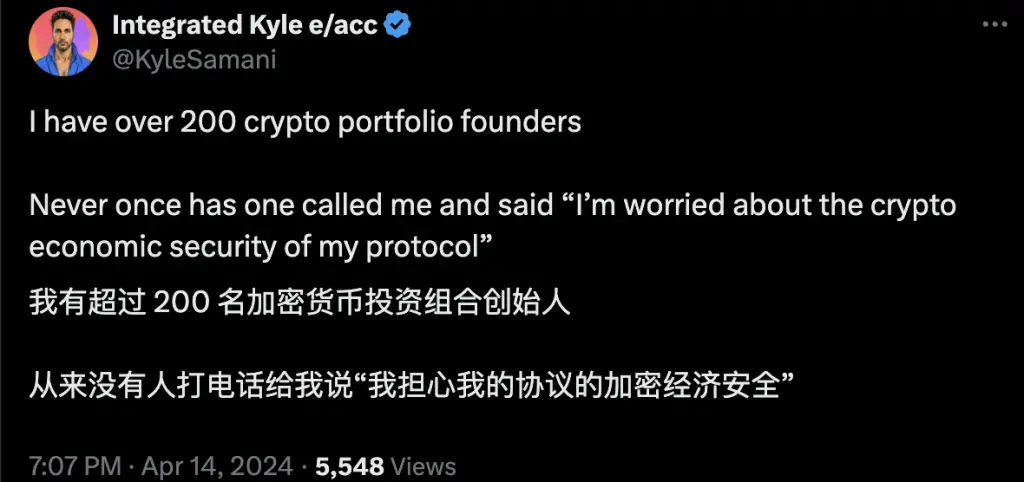 Kyle Samani, founder of Multicoin, questions the restaking business model Source: X
Kyle Samani, founder of Multicoin, questions the restaking business model Source: X
From the perspective of Eigenlayer's target users who have already issued tokens: oracles (LINK, PYTH), bridges (AXL, ZRO), DA (TIA, AVAIL), maintaining protocol security through staking tokens is a core use case of their tokens. Choosing to purchase security services from Eigenlayer would greatly undermine the rationale for issuing their tokens. Even Eigenlayer itself, when explaining the EIGEN token, expressed the view that "using EIGEN to maintain protocol security" is a primary use case in very abstract and obscure language.
The Survival Path of Liquid Restaking (Etherfi)
Eigenlayer supports two ways to participate in restaking: using LST and native restaking. Participating in Eigenlayer Restaking using LST is relatively simple; users deposit ETH into the LST protocol to obtain LST, then deposit the LST into Eigenlayer. However, LST pools have long-term caps, and users who want to participate in restaking during the cap period need to follow these steps for native restaking:
- Users must first complete the entire staking process on the Ethereum network, including preparing funds, configuring execution layer and consensus layer clients, and setting withdrawal credentials.
- Users create a contract account named Eigenpod in Eigenlayer.
- Users set the withdrawal private key of their Ethereum staking node to the Eigenpod contract account.
It can be seen that Eigenlayer's Restaking is a relatively standard 're'staking. Whether users deposit other LSTs into Eigenlayer or engage in native restaking, Eigenlayer does not directly "touch" the ETH that users stake (Eigenlayer also does not issue any LRT). The process of native restaking is a "complex version" of ETH's native staking, meaning similar financial, hardware, network, and knowledge barriers.
Thus, projects like Etherfi quickly provided Liquid Restaking Tokens (LRTs) to address this issue. The operational process of Etherfi's eETH is as follows:
- Users deposit ETH into Etherfi, and Etherfi issues eETH to users.
- Etherfi stakes the received ETH to obtain the basic staking rewards of ETH;
- At the same time, they follow Eigenlayer's native restaking process to set the withdrawal private key of the node to the Eigenpod contract account, thus obtaining Eigenlayer's restaking rewards (as well as $EIGEN and $ETHFI).
Clearly, the service provided by Etherfi is the optimal solution for users holding ETH who want to earn rewards: on one hand, the eETH operation is simple and also has liquidity, providing an experience similar to Lido's stETH; on the other hand, users depositing ETH into Etherfi's eETH pool can earn approximately: 3% basic ETH staking rewards, potential AVS rewards from Eigenlayer, token incentives (points) from Eigenlayer, and token incentives (points) from Etherfi.
eETH accounts for 90% of Etherfi's TVL, contributing to a peak TVL of over $6 billion and a maximum FDV of $8 billion, making Etherfi the fourth-largest staking entity in just six months.
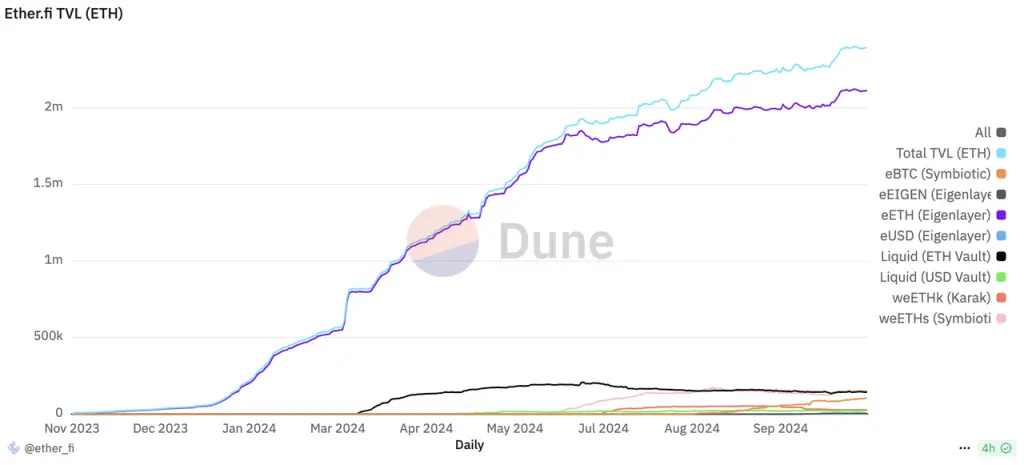 Etherfi TVL Distribution Source: Dune
Etherfi TVL Distribution Source: Dune  Staking Volume Rankings Source: Dune
Staking Volume Rankings Source: Dune
The long-term business logic of the LRT protocol lies in helping users participate in both staking and restaking in a simpler manner, thereby obtaining higher returns. Since it does not generate any revenue (other than its own token), the overall business logic of the LRT protocol is more akin to a specific yield aggregator for ETH. If we analyze carefully, we will find that its business logic relies on the following two premises:
- Lido cannot provide liquid restaking services. If Lido were willing to "emulate" eETH with its stETH, Etherfi would find it very difficult to match its long-term brand advantage, security endorsement, and liquidity advantage.
- Eigenlayer cannot provide liquid staking services. If Eigenlayer were willing to directly accept users' ETH for staking, it would also greatly undermine Etherfi's value proposition.
From a purely business logic perspective, it is entirely feasible for Lido, as the leader in liquid staking, to provide liquid restaking services to offer users a broader range of income sources, and for Eigenlayer to directly accept user funds for easier staking & restaking. So why doesn't Lido do liquid restaking, and why doesn't Eigenlayer do liquid staking?
I believe this is determined by the special circumstances of Ethereum. In May 2023, when Eigenlayer had just completed a new round of $50 million financing, sparking numerous discussions in the market, Vitalik specifically wrote an article titled "Don't overload Ethereum's consensus" to elaborate on how Ethereum's consensus should be reused (i.e., "how should we restake").
Regarding Lido, due to its long-term market share of about 30% of Ethereum staking, there have been constant voices within the Ethereum Foundation to constrain it. Vitalik has also personally written multiple articles discussing the centralization issues of staking, which has forced Lido to prioritize "alignment with Ethereum," gradually shutting down all its businesses on other chains, including Solana. Its de facto leader, Hasu, confirmed in a May article that he would abandon the possibility of entering the restaking business, limiting Lido's operations to staking, and instead investing in and supporting the restaking protocol Symbiotic, as well as establishing the Lido Alliance to respond to competition from LRT protocols like Eigenlayer and Etherfi for its market share.
Reaffirm that stETH should stay an LST, not become an LRT.(Reaffirm that stETH should remain an LST, not become an LRT)
Support Ethereum-aligned validator services, starting with preconfirmations, without exposing stakers to additional risk.(Support Ethereum-aligned validator services, providing pre-confirmations without adding risk to stakers)
Make stETH the #1 collateral in the restaking market, allowing stakers to opt into additional points on the risk and reward spectrum.(Make stETH the largest collateral in the restaking market, offering stakers choices across different risk and reward profiles)
Lido's stance on restaking-related matters Source
On the Eigenlayer side, Ethereum Foundation researchers Justin Drake and Dankrad Feist were hired as consultants by Eigenlayer early on. Dankrad Feist stated that his main purpose for joining was to ensure "Eigenlayer aligns with Ethereum," which may also explain why Eigenlayer's native restaking process is quite contrary to user experience.
In a sense, the market space for Etherfi has been brought about by the Ethereum Foundation's "distrust" of Lido and Eigenlayer.
Analysis of Ethereum Staking Ecosystem Protocols
Combining Lido and Eigenlayer, we can see that in the current PoS chains, there are three long-term sources of income surrounding staking behavior, aside from the associated token incentives:
- PoS underlying rewards, which are native tokens paid by the PoS network to maintain network consensus. The yield of this part mainly depends on the chain's inflation plan. For example, Ethereum's inflation plan is linked to the staking ratio; the higher the staking ratio, the slower the inflation rate.
- Transaction ordering revenue, which includes fees that nodes can obtain during the transaction packaging and ordering process, including priority fees paid by users and MEV revenue obtained during transaction packaging and ordering. The yield of this part mainly depends on the chain's activity level.
- Staked asset rental income, which involves lending users' staked assets to other protocols that have demand, thus obtaining fees paid by these protocols. This income depends on how many protocols with AVS needs are willing to pay for protocol security.
Currently, there are three types of protocols surrounding staking behavior on the Ethereum network:
- Liquid staking protocols represented by Lido and Rocket Pool. They can only obtain the first and second types of income mentioned above. Of course, users can use their LST to participate in restaking, but as protocols, they can only take a cut from the first and second types.
- Restaking protocols represented by Eigenlayer and Symbiotic. These protocols can only obtain the third type of income mentioned above.
- Liquid restaking protocols represented by Etherfi and Puffer. They theoretically can obtain all three types of income mentioned above, but they are more like "aggregators of restaking income for LST."
Currently, the PoS underlying yield for ETH is around 2.8% annually, which gradually decreases as the staking ratio increases;
Transaction ordering revenue has significantly decreased with the launch of EIP-4844, recently hovering around 0.5%.
The base for staked asset rental income is still small and cannot be annualized yet, relying more on EIGEN and associated LRT protocol token incentives to make this income substantial.
For LST protocols, their revenue base is the amount staked * staking yield. The amount of ETH staked is approaching 30%. Although this figure is still significantly lower than other PoS public chains, from the perspective of the Ethereum Foundation's decentralization and economic bandwidth, they do not want too much ETH to flow into staking (see Vitalik's recent blog post, the Ethereum Foundation once discussed whether to set a cap on ETH staking at 25% of the total); while the staking yield has been continuously declining, stabilizing at around 6% since the end of 2022, often achieving around 10% short-term APR, and now only at 3%, with no reason for recovery in the foreseeable future.
For the tokens of the aforementioned protocols, aside from being constrained by the overall downturn of ETH:
The market ceiling for Ethereum's LST is gradually becoming visible, which may also be the reason for the poor performance of the governance tokens of LDO and RPL;
For EIGEN, currently, restaking protocols on other PoS chains, including those on the BTC chain, are continuously emerging, limiting Eigenlayer's business essentially to the Ethereum ecosystem, further reducing the potential upper limit of its already unclear AVS market size;
The emergence of LRT protocols, which were not anticipated (with ETHFI's peak FDV exceeding $8 billion, surpassing the historical highs of LDO and EIGEN), has further "diluted" the value of the aforementioned two in the staking ecosystem;
For ETHFI and REZ, besides the aforementioned factors, the excessively high initial valuations brought by launching during market enthusiasm are more significant factors affecting their token prices.
Staking and Restaking on Solana
The operational mechanism of liquid staking protocols on the Solana network, represented by Jito, is fundamentally no different from that of the Ethereum network. However, Solayer's restaking is different from Eigenlayer's restaking. To understand Solayer's restaking, we first need to understand Solana's swQoS mechanism.
The swQoS (stake-weighted Quality of Service) mechanism on the Solana network officially came into effect after a client version upgrade in April this year. The swQoS mechanism aims to enhance the overall efficiency of the network, as the Solana network experienced prolonged network congestion during the meme frenzy in March.
In simple terms, after swQoS is enabled, block producers determine the priority of their transactions based on the amount staked by the stakers. Stakers holding x% of the total network stake can submit a maximum of x% of the transactions (for more details on the specific mechanism of swQoS and its profound impact on Solana, readers can refer to Helius's article). After swQoS was enabled, the transaction success rate on the Solana network rapidly increased.
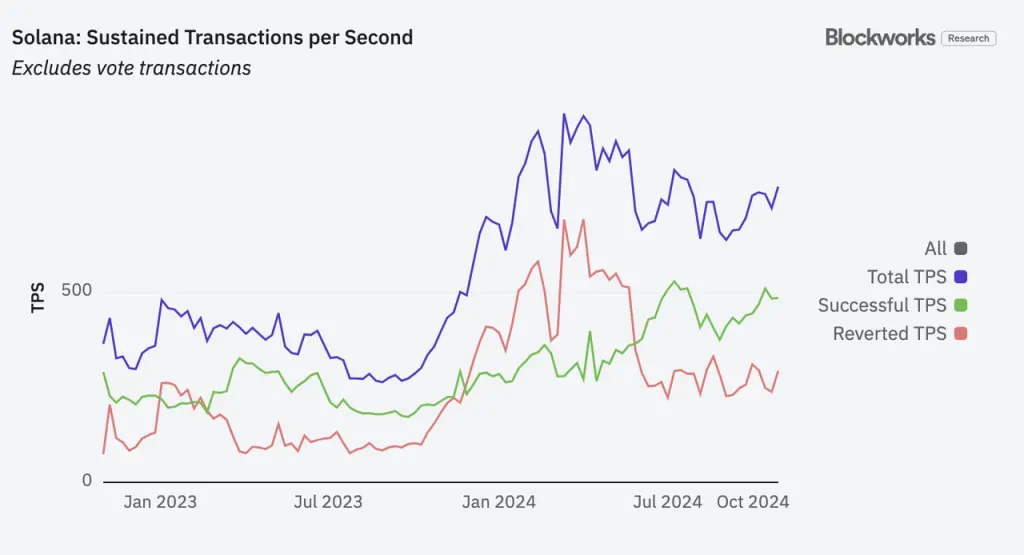 Solana Network Successful and Failed TPS Source: Blockworks
Solana Network Successful and Failed TPS Source: Blockworks
swQoS prioritizes the rights of larger stakers by "drowning" the transactions of smaller stakers when network resources are limited, thus avoiding malicious attacks on the system. To some extent, the logic of "the more you stake, the more network privileges you enjoy" aligns with the logic of PoS public chains: staking a larger proportion of the chain's native tokens contributes more to the stability of the chain and the native tokens, thus enjoying more privileges is only natural. Of course, the centralization issues of this mechanism are also very evident: larger stakers can naturally obtain more priority transaction rights, which will attract more stakers, thereby self-reinforcing the advantages of top stakers, further leaning towards oligopoly or even monopoly. This seems to contradict the decentralization advocated by blockchain, but this is not the focus of this article. We can clearly see from Solana's consistent development history that Solana adopts a pragmatic attitude of "performance first" regarding decentralization issues.
Against the backdrop of swQoS, Solayer's target users for restaking are not oracles or bridges, but protocols that require transaction throughput/reliability, typically DEXs. Therefore, Solayer refers to the AVS services provided by Eigenlayer as exogenous AVS, as these systems typically reside outside the Ethereum main chain. In contrast, the services it provides are termed endogenous AVS, as its service targets are located within the Solana main chain.
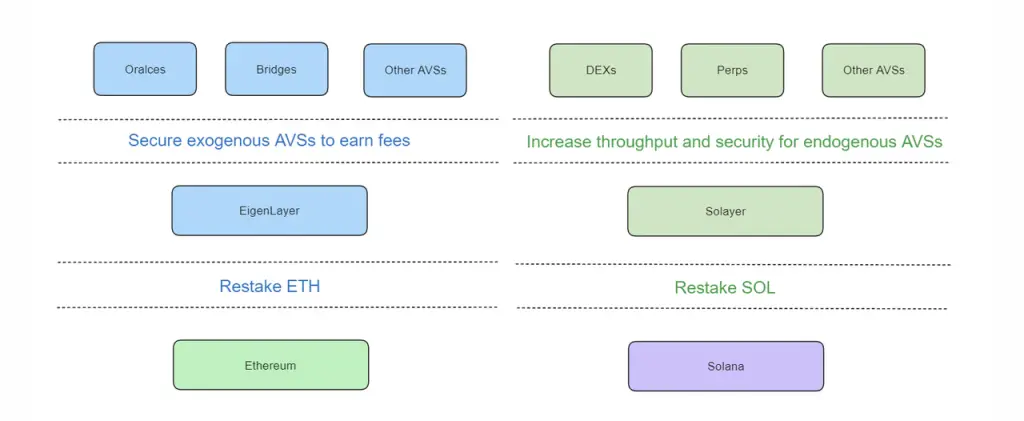 Differences between Solayer and Eigenlayer Source
Differences between Solayer and Eigenlayer Source
It can be seen that although both involve leasing staked assets to other protocols with demand for 're'staking, Solayer's endogenous AVS and Eigenlayer's exogenous AVS provide fundamentally different core services. Solayer's endogenous AVS is essentially a "transaction throughput leasing platform," with demand users being platforms (or their users) that require transaction throughput, while Eigenlayer is a "protocol security leasing platform." The core support for its endogenous AVS is Solana's swQoS mechanism. As Solayer states in its documentation:
We did not fundamentally agree with EigenLayer's technical architecture. So we re-architected, in a sense, restandardized restaking in the Solana ecosystem. Reusing stake as a way of securing network bandwidth for apps. We aim to become the de facto infrastructure for stake-weighted quality of service, and eventually, a core primitive of the Solana blockchain/consensus.
"We fundamentally disagree with EigenLayer's technical architecture. Therefore, in a sense, we have restructured restaking in the Solana ecosystem. Reusing stake as a means to secure network bandwidth for applications. Our goal is to become the de facto infrastructure for swQoS and eventually a core primitive of the Solana blockchain/consensus."
Of course, if there are other protocols on the Solana chain that have demand for staked assets, such as those requiring protocol security, Solayer can also lease its SOL to these protocols. In fact, from a definitional standpoint, any leasing/reutilization of staked assets can be termed restaking, not limited to security needs. Due to the existence of the swQoS mechanism on the Solana chain, the scope of restaking business on Solana is broader than that on Ethereum, and from Solana's recent surge in on-chain activity, the demand for transaction throughput appears to be more rigid than the demand for security.
Is Solayer's Restaking a Good Business?
The business process for users participating in Solayer restaking is as follows:
- Users deposit SOL directly into Solayer, and Solayer issues sSOL to users.
- Solayer stakes the received SOL to obtain basic staking rewards.
- At the same time, users can delegate sSOL to protocols that require transaction throughput, thus earning fees paid by these protocols.
 Current Solayer AVS Source
Current Solayer AVS Source
It can be seen that Solayer is not only a restaking platform but also a restaking platform that directly issues LST, resembling Lido on the Ethereum network that supports native restaking.
As mentioned earlier, there are three sources of income surrounding staking behavior, and the situation of these three types of income on the Solana network is as follows:
- PoS underlying income, which is the SOL paid by Solana to maintain network consensus, with an annual yield of around 6.5%, this income is relatively stable.
- Transaction ordering income, which includes fees that nodes can obtain during the transaction packaging and ordering process, including priority fees paid by users to expedite transactions and tips paid by MEV searchers. The combined yield is approximately 1.5% annually, but it varies significantly depending on on-chain activity.
- Staked asset rental income, which involves lending users' staked assets to other protocols with demand (transaction throughput, protocol security, or others). Currently, this part has not yet scaled.
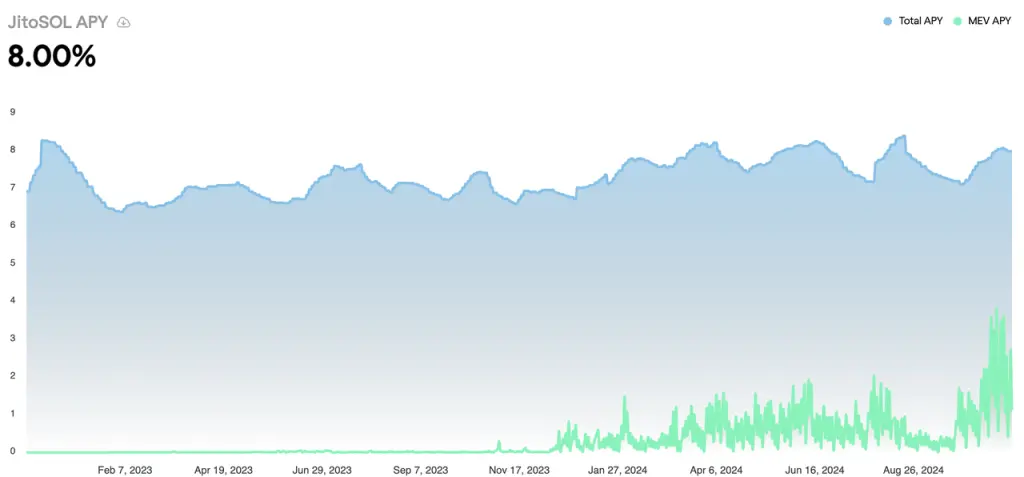 Total yield and MEV yield of SOL liquid staking (using JitoSOL as an example) Source: Jito
Total yield and MEV yield of SOL liquid staking (using JitoSOL as an example) Source: Jito
If we carefully compare the three types of income between Ethereum and Solana, we will find that although the market cap of SOL is still only 1/4 of ETH, and the market cap of staked SOL is about 60% of that of staked ETH, the staking-related protocols on the Solana chain have in fact a larger market and a greater potential market than those on the Ethereum chain because:
In terms of PoS underlying income: The network issuance rewards that SOL is willing to pay have already surpassed ETH since December 2023, and the gap between the two continues to widen. Whether for ETH or SOL staking, this accounts for over 80% of their yield, determining the income baseline for all staking-related protocols.
 Ethereum and Solana Token Issuance Rewards (i.e., PoS underlying income of the network) Source: Blockworks
Ethereum and Solana Token Issuance Rewards (i.e., PoS underlying income of the network) Source: BlockworksIn terms of transaction ordering income: Blockworks uses transaction fees and MEV tips to reflect the real economic value (REV, Real Economic Value) of a chain. This metric can closely approximate the maximum transaction ordering income a chain can achieve. We can see that despite the significant fluctuations in REV for both chains, Ethereum's REV sharply declined after the Cancun upgrade, while Solana's REV has shown an overall upward trend and recently surpassed Ethereum.
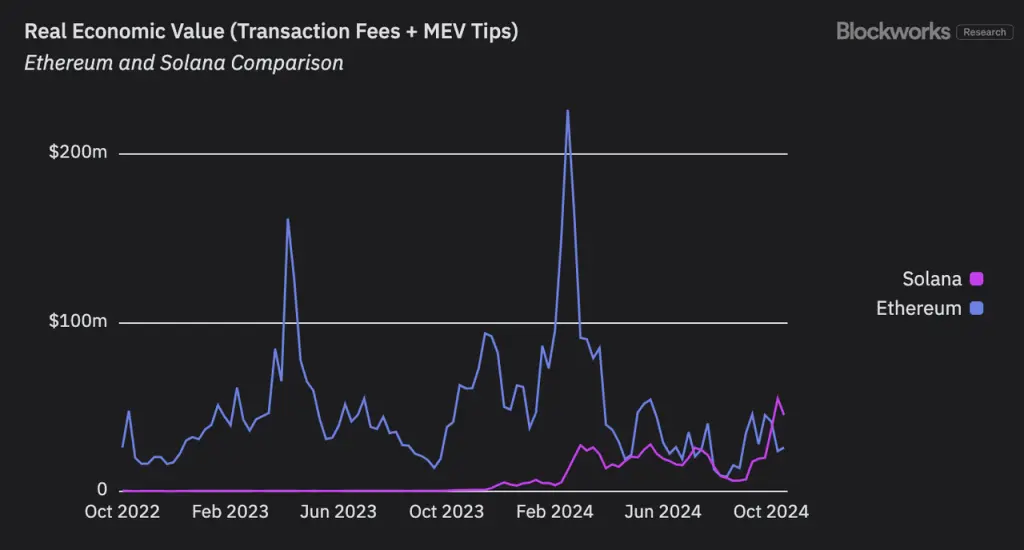 Solana and Ethereum's REV Source: Blockworks
Solana and Ethereum's REV Source: BlockworksIn terms of staked asset rental income, compared to the Ethereum network, which currently only has security income, Solana's swQoS mechanism can bring additional demand for transaction throughput leasing.
Furthermore, Solana's staking-related protocols can expand their business according to commercial logic; any liquid staking protocol can conduct restaking business, as seen with Jito; any restaking protocol can also issue LSTs, such as Solayer and Fragmetric.
More importantly, we currently see no possibility of reversal for the above trends, meaning that the advantages of Solana's staking protocols relative to Ethereum's staking protocols may continue to expand.
From this perspective, although we still cannot say that Solana's restaking has found PMF, it is clear that Solana's staking and restaking are better businesses than those on Ethereum.






